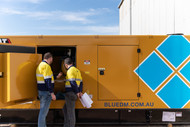Is Your Generator Underloaded? | Everything You Need to Know
14th Jun 2022
Generators provide mass amount of energy output capable of running worksites, agricultural equipment and entire mining operations. But what happens when it doesn’t get to reach its optimum power capacity?
Here’s everything you need to know about generator underloading, how to fix it and how to prevent it from happening.
What is Generator Underloading?
Generator underloading or “wet-stacking” is what happens when you run your generator with lighter loads than what it’s built for. So, when the load (power output from the generator) doesn’t match what the application requires, it won’t run at it optimal consumption.
Consistently running a generator on light loads rather than what it’s designed for can be problematic to your investment and operation.
What Are the Effects of a Low Load On Your Generator?
When this happens, the generator has to work harder because it’s not reaching the temperature it needs to operation adequately. This causes subsequent wear and tear, strain on the engine and glowplugs to remain as efficient as possible. This can also cause soot-build up that can end up clogging the cylinders. If these issues occur, the generator won’t be able to operate.
More seriously, running your generator at lighter loads also causes glazing. This happens when the operating temperatures are not met, causing any unburnt fuel to become a thick consistency. This can gradually clog the generators piston rings as well as destroy the seal. . As a result, combustion exhaust gasses slip past the piston rings and, when combined, with the substance, creates a hard coating that will quickly destroy the generator.
What are the signs of Generator Underloading?
Common signs of underloading include:
- Heavy smoke coming from the exhaust while the generator is running
- Unburnt diesel comes a syrup-like consistency
- Soot or fuel mixture seeping out of the exhaust
How Can I Prevent Generator Underloading?
Failure to prevent underloading can result in serious damage to the generator and is usually not covered under warranty. With that being said, the most effective way to prevent your generator from underloading, is to make sure you’re purchasing a generator with the right kVA output you need for the application. Otherwise, here’s what help can help:
- If your generator is already being underloaded, try and keep it running at its optimal capacity (around 70 - 100%) for around 2 hours in every 100 hours of use.
- Implement the use a load bank to help facilitate reaching its load capacity. This can help to gradually burn off any unburnt fuel and prolong the life of the Genset.
- Regular servicing, maintenance and tests to help prevent the effects of underloading
If you are unsure about what kVA output you require for your application, be sure to speak to one of Blue Diamond Machinery’s expert team.
Need Expert Advice? We’re Here to Help.
With years of experience servicing the mining and construction industries, Blue Diamond Machinery has the equipment you need and can rely on. We not only offer expert advice and industry-leading warranties, we provide an all-encompassing power solution. We will customise and install your power solution to your specific power demand requirements, wherever you are. Get in touch with our team today.




